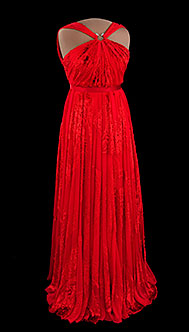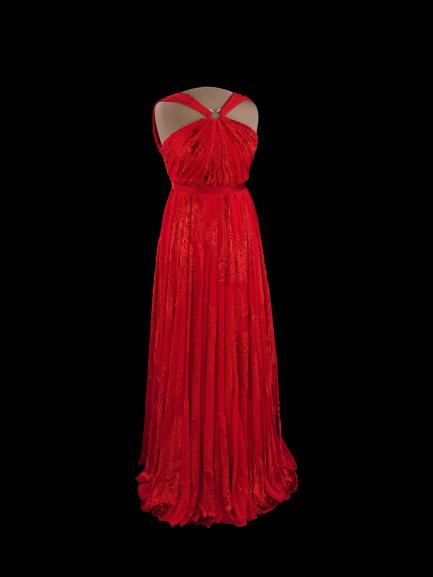The Smithsonian’s National Museum of American History will display First Lady Michelle Obama’s second inaugural gown worn to the January 2013 inaugural balls beginning Jan. 14.
Michelle Obama’s Second Inaugural Ball Gown Goes on View in National Museum of American History
The Smithsonian’s National Museum of American History will display First Lady Michelle Obama’s second inaugural gown worn to the January 2013 inaugural balls beginning Jan. 14. This special one-year loan from the White House coincides with the centennial of the First Ladies exhibition at the Smithsonian and the museum’s 50th anniversary. The gown will be displayed in the center of the museum’s popular exhibition, “The First Ladies.”
The long ruby-colored chiffon gown, with a cross-halter strap neckline and deep back, custom-made by designer Jason Wu, features velvet details. Obama paired the gown with shoes designed by Jimmy Choo, which will also be displayed alongside the gown. The white dress from the first Obama inauguration, which was a gift to the museum, will not be on display for the year.
For a century, the First Ladies Collection has been one of the most popular attractions at the Smithsonian. The original First Ladies exhibition opened Feb. 1, 1914, and was the first display at the Smithsonian to prominently feature women. The exhibition itself has changed in size, location, style and focus several times during the past 100 years, and the museum, which opened in 1964 as the Museum of History and Technology, has been its home for 50 years.
“We hope that this loan begins a new tradition of allowing the public to see the second inaugural gown before it goes on display in the future presidential library,” said John Gray, director of the museum. “The donation of the first inaugural gown to the Smithsonian is a long-held tradition and this loan will enhance the visitors’ experience to one of the most popular attractions at the Smithsonian.”
The museum’s current “The First Ladies” exhibition opened Nov. 19, 2011, and features 26 dresses and more than 160 other objects, ranging from those of Martha Washington to Michelle Obama, and includes White House china, personal possessions and other objects from the Smithsonian’s unique collection of First Ladies’ materials, established in 1912. Among the dresses displayed in the exhibition are Grace Coolidge’s flapper-style evening gown, Jackie Kennedy’s yellow-silk gown worn to the Kennedy administration’s first state dinner in 1961 and Eleanor Roosevelt’s slate blue crepe gown, which she wore to the 1933 inaugural ball.
First Ladies are unofficial but important members of presidential administrations. For more than 200 years the public has judged their clothes, their parties, their projects and their roles in the White House. The exhibition examines this in four main sections:
The “Fashionable First Lady” explores the public’s interest in the First Ladies’ fashions. Only a few First Ladies have become fashion icons, inspiring trends and promoting American designers, but all have had their wardrobes scrutinized by the American public, continuing the debate over what is “appropriate” for presidential style.
The “Nation’s Hostess” looks at the role that the First Lady has played for the nation and the presidential administrations. Each reception or dinner is an opportunity for the First Lady to help build America’s international relationships, win political friends and public support for the President, or further his administration’s legislative agenda. Each First Lady puts her own stamp on presidential hospitality.
“Inauguration and Opportunities” looks at the inauguration of a President as a time of optimism and new beginnings. In addition to attending ceremonies and balls, incoming First Ladies announce the agendas and special projects they intend to pursue. Some projects are ambitious. Some are traditional. Some may be controversial.
“Changing Times, Changing First Ladies” highlights Dolley Madison, Mary Lincoln, Edith Roosevelt and Lady Bird Johnson, who all fashioned their own ways of handling the White House, families, parties and politics. During different times and circumstances they crafted significant roles for themselves that they believed would allow them to best serve the President and the country.
Public Program
The First Ladies Exhibition: Changing Fashions, Changing Roles
Warner Bros. Theater
Wednesday, March 12; 6:45 p.m. to 8:45 p.m.
Visitors can mark Women’s History Month and 100 years of First Ladies at the Smithsonian with Political History Curator Lisa Kathleen Graddy as she shares how the original collection of dresses evolved into an exhibition with a broader focus on the contributions of First Ladies to the presidency and society. Michelle Obama’s 2009 inauguration gown will be on special display during the program, and a book signing will follow. Attendance is free, but tickets are required and available at Smithsonian Associates tickets.
Book
The Smithsonian First Ladies Collection by Lisa Kathleen Graddy and Amy Pastan is an illustrated book inspired by one of the most popular attractions at the Smithsonian: the First Ladies exhibition at the National Museum of American History. It showcases treasures from First Ladies ranging from Martha Washington’s silk dress and dressing mirror to Michelle Obama’s 2009 inaugural gown and jewelry. These and many other objects—including gowns, tableware and invitations from beloved First Ladies such as Mamie Eisenhower, Jacqueline Kennedy, Barbara Bush, Hilary Clinton and more—tell the story of the First Ladies as public and private figures. The Smithsonian First Ladies Collection features many treasures not currently on view and offers a view into these women and their roles in American culture and political life. (The Smithsonian First Ladies Collection, published by Smithsonian Press, April 1, 2014.)
About the Museum
Through incomparable collections, rigorous research and dynamic public outreach, the National Museum of American History explores the infinite richness and complexity of American history. The museum helps people understand the past in order to make sense of the present and shape a more humane future. It is currently renovating its west exhibition wing, developing galleries on business, democracy and culture. For more information, visit http://americanhistory.si.edu. The museum is located at 14th Street and Constitution Avenue N.W., and is open daily from 10 a.m. to 5:30 p.m. (closed Dec. 25). Admission is free.
# # #
SI-505-2013


